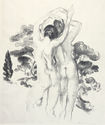
19th, 20th & 21st Century Fine Prints
707-546-7352 · fax 707-546-7924 · web: www.annexgalleries.com · email: artannex@aol.com
Arthur Bowen Davies Biography
Arthur Bowen Davies
American
1862–1928
Biography
Arthur Bowen Davies, was born on September 26, 1862, in Utica, New York. He studied in Utica, New York City and Chicago, Illinois. It was after 1900 that his most characteristic works were created—idyllic scenes of elegant nude figures and mythological creatures gracefully grouped in frieze-like compositions before stark Romantic landscapes. In 1908 Davies organized an exhibit of artists who came to be known as ‘The Eight’ or ultimately as the ‘Ashcan School’, which also included leader Robert Henri, John Sloan, Ernest Lawson, Maurice Prendergast, George Luks, William Glackens and George Bellows.
As president of the Society of Independent Artists, Davies was a major figure in the organization of the controversial 1913 Armory Show in New York, which brought the works of European and American modernists to the attention of the U.S. public. Davies personally selected many of the contemporary European paintings for the Armory Show, in which six of his own works were exhibited. Davies was also responsible for aiding Alfred H. Barr, Jr. in the foundation of the Museum of Modern Art in New York.
Despite rejecting avant-garde styles in his own work, Davies remained a staunch supporter of abstract art throughout his life. Davies’s painting won numerous honors in his lifetime, among them the first Clark Prize at the Corcoran Biennial of 1916. Art historian Milton Brown wrote of Davies' early period: "A product of the Tonalist school and Whistler, he had developed a unique decorative style. He was completely eclectic."
Davies himself adopted a modified Cubist style for several years and painted rhythmic patterns of geometricized fragments of natural forms and figures. During the last decade of his career he returned to a representational style and devoted much of his time to printmaking, primarily etching and lithography.
Arthur Bowen Davies died on October 24, 1928 in Florence, Italy.




